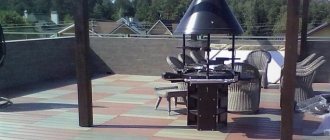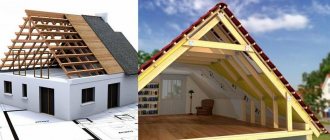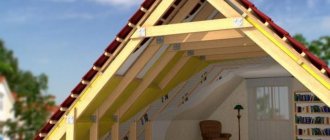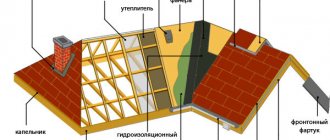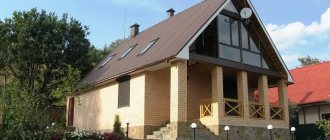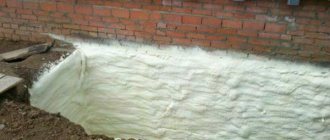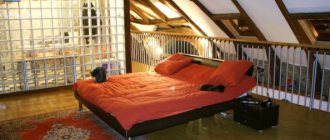Attic insulation scheme.
Several different materials are used as insulation: mineral and glass wool, polystyrene foam, polyurethane foam, and other insulation materials. But not all of these materials are suitable for carrying out work on thermal insulation of an attic space for converting it into a real attic.
Methods for insulating the attic
Insulation of the attic can be done in two ways: from the outside and from the inside. Whichever you choose, be sure to follow the general rules.
- Thermal insulation material must be selected in accordance with norms and standards.
- Air gaps should be left in the structure to allow air to drain from the under-roof space.
- The thickness of the insulation should not be less than that recommended for the corresponding climatic zone.
External thermal insulation
This method allows you to best protect the roof from freezing and avoid the formation of condensation between the roof and the insulation. However, it is suitable only for those who are thinking about insulating the space under the roof during the construction stage. By the way, you can make a competent house design yourself using special programs for designing houses.
Insulation of the attic from the outside is carried out only in warm and dry weather. For external insulation, two methods of laying insulation are suitable: on top of the rafters and between them. Professional craftsmen use the first one, when the insulating material is laid close to each other and does not allow cold bridges to form.
Cold bridges are areas through which heat loss occurs. Most often they occur at the joints of parts of the insulating structure.
Internal thermal insulation
If the roof has already been covered with roofing material, the method of insulating the attic from the inside will suit you. Its main advantage is that insulation work can be carried out in any weather. When insulating an attic from the inside, the dew point moves inside the room, so proper waterproofing is necessary.
Calculation of the amount of foam
Before starting work, it is necessary to calculate the thickness of the attic insulation and, accordingly, determine the number of foam boards so that the entire area of the roof structure is covered. At the same time, you need to buy the material with a reserve, since an unforeseen situation may arise during the installation process. For example, when cutting foam plastic, the material needed to be given a certain shape, but a mistake was made. Other troubles are also possible. Therefore, if calculations have shown that at least 40 slabs will be required, it is advisable to purchase 50 before insulating the attic roof.
If the material remains, it will be useful in the future to replace elements that have become unusable. During transportation, foam plastic must be protected from mechanical damage and physical stress, and if it is transported in an open body, then also from precipitation.
Choosing insulation for an attic roof
If you are insulating a room yourself, then one of the most difficult tasks is choosing insulation. There is such a huge range of types and brands of materials on the building materials market that you simply get lost.
When I decided to insulate the attic, I had a choice between polystyrene foam and mineral wool. However, it turned out that there are many more insulating materials, and each has its own pros and cons.
A master builder with 20 years of experience advised me to choose insulation for the attic for winter living in accordance with the following requirements:
- thermal conductivity coefficient no more than 0.04 W/mS;
- noise absorption coefficient from 0 to 1;
- vapor permeability not higher than 0.5 mg/(m*h*Pa);
- fire safety class NG or G1;
- load reliability factor is about 1.3 Yf;
- environmental safety close to class A;
- efficiency;
- no difficulties during installation.
Below we will consider in detail which insulation materials meet these requirements.
Styrofoam
Polystyrene foam is made by foaming polymers. The bulk of polystyrene foam consists of air, so it has low weight and good thermal insulation properties. The positive qualities include moisture resistance, excellent sound insulation and low cost.
Foam plastic retains its performance properties in a fairly wide range from -50 to +75 °C. There are no problems when working with it. Polystyrene foam can be easily cut with a knife, and it can be attached to the surface using glue.
Disadvantages include the fragility of the material. During the cutting process, the edges of the foam crumble, so there are gaps at the joints where cold bridges can form. The main disadvantage of polystyrene foam is its high flammability, so it cannot be used in areas with a high fire hazard.
Extruded polystyrene foam
During the production process, expanded polystyrene is subjected to high-temperature treatment, due to which, despite the small thickness of the material, it has high heat-shielding properties and good strength. With all the positive properties, the material also has disadvantages. The cost of this insulation is approximately 2 times higher than the cost of polystyrene foam. The material is made from plastic, so it cannot be called environmentally friendly.
Although manufacturers claim that polystyrene foam is resistant to fire, practice shows the opposite. As for sound insulation, compared to polystyrene foam and mineral wool, polystyrene foam has lower performance.
Mineral wool
Mineral wool has a fibrous structure and is available in rolls and mats. It is made from natural ingredients with a small amount of synthetic binders, and therefore is highly environmentally friendly.
It has high heat-protective and sound-proofing qualities. This is especially important if there is a bedroom in the attic. Agree, it’s difficult to sleep when rain is drumming on the roof. Insulating the roof with mineral wool solves this problem.
Mineral wool is not afraid of fire and high temperatures, melts only at a temperature of 1000 °C, so it is often chosen for insulating wooden houses. It is highly resistant to temperature changes and chemicals. At the same time, the material has a low cost, on average about 600 rubles per square meter. m.
The main disadvantage of mineral wool is its increased hygroscopicity, so it requires mandatory waterproofing.
Hygroscopicity is the ability of insulation to absorb moisture from the environment.
Glass wool
Glass wool is a type of mineral wool. Its difference lies in its production technology; it is made from molten glass. It has the same pros and cons as mineral wool.
Stone wool
Basalt, or stone wool, is made from molten rocks. It is also a derivative of mineral wool, and therefore has the same qualities as the previous two.
Ecowool
Ecowool is a relatively new type of insulation, which is made from cellulose waste. The material consists of 80% loose paper fiber, the remaining 12% is a natural antiseptic boric acid and 8% is borax, which is added to reduce the attractiveness of ecowool for insects and rodents.
Ecowool has low water permeability and a high degree of sound insulation due to hollow holes in the insulation fibers, which absorb sound and do not allow moisture to pass through. Since synthetic materials are not used in the production of ecowool, it is environmentally friendly.
The level of thermal protection of ecowool is approximately the same as that of mineral wool. When wet, the insulation does not lose its protective properties. Has good adhesion to almost any material.
The disadvantages include low rigidity, which requires the installation of additional supporting structures. The material has a high shrinkage (after 2 years it sags significantly), so experts recommend increasing the ecowool layer during installation by 30% of the calculated value.
Ecowool, although it does not burn, does smolder, so it cannot be called completely fireproof. The relatively low price of the material (from 50 rubles per kg) is offset by the high cost of installation. For work on ecowool insulation, specialists charge from 1000 rubles per 1 sq. m. m. Without special additional equipment, it will not be possible to insulate the attic with ecowool yourself.
Polyurethane foam
Polyurethane foam is a sprayed insulation material, it is obtained by the synthesis of two components: a polyol and a polyisocyanate. During the reaction, carbon dioxide is intensively released, resulting in a foamed, dense insulating material.
Thanks to its dense porous texture, it provides good thermal protection. For comparison: the thermal conductivity of polyurethane foam is 0.02 W/m, and that of mineral wool is 0.05 W/m. PPU has higher sound insulation rates compared to other insulation materials, as it has a higher density and cellular structure.
Due to the continuous application there are no joints, so cold bridges do not form in it. Using polyurethane foam you can insulate the most complex structures and shapes.
The insulation has excellent adhesion to all types of materials, except polyethylene. It is a non-combustible material and is a leader among other insulation materials in terms of moisture resistance. It has high performance properties and can withstand temperatures ranging from -160… +150 °C.
The downside is the labor-intensive installation technology, which does not allow you to do the work yourself. Insulation requires specialized installation equipment and is expensive. Application with a layer of 15 cm will cost you from 1200 rubles/sq.m. m.
Since polyurethane foam is a vapor-proof material, an attic insulated with it will need forced ventilation.
Penofol
The insulation consists of foamed polyethylene, covered on one or both sides with aluminum foil. Penofol is popular because with a small thickness of the material - from 2 mm to 4 cm - it has high heat-protective, vapor barrier and noise-reducing properties.
Aluminum foil covering penofol reflects thermal radiation, while polyethylene foam, on the contrary, absorbs thermal energy. This combined technology allows you to reliably insulate the room. Aluminum foil and polyethylene foam have a vapor permeability below 0.001 mg/(m*h*Pa), so it reliably protects the structure from evaporation.
The insulation does not require additional waterproofing. It is light in weight, easy to cut with a knife and easy to install. Environmentally friendly. Penofol is a highly flammable material. The average price for penofol is about 100 rubles/sq.m. m.
Among the disadvantages, it is worth noting the low rigidity of the material, so it will not be possible to apply finishing materials directly to it. Penofol should be used carefully in places where electrical wires and equipment come into contact, as it is a conductor of electricity.
Criterias of choice
Insulating an attic is a much more complex process than insulating floors, walls, windows and basements.
What matters here is the specificity of the sloping roof, which usually forms the attic, and the presence of sheathing - the insulation must be laid between the rafters and behind them, securely fixed and not change shape for a long time, despite the vertical location, it should not move away and sag.
It is also necessary to insulate the walls, ceilings, floors, gables - a fairly rigid material with good insulating properties is required.
If you choose between expanded polystyrene, polystyrene foam and mineral wool, you should choose the latter. Despite its higher cost, mineral wool has a whole range of useful properties that are superior to other heat-insulating materials.
It is environmentally friendly, retains its shape better than polystyrene foam and polystyrene foam, is not afraid of mice, unlike polystyrene foam, and unlike polystyrene foam, it is better ventilated and allows you to efficiently insulate the room, taking into account the need to live in it in the summer.
How to calculate the required insulation thickness yourself
The optimal thickness of the layer of insulation material depends on the climate zone, the area of the attic, and the thermal conductivity of the insulation. You can calculate it yourself using the formula.
δut=(R-0.16-δ1/λ1 -δ2/λ2 -δi/λi )×λut
Wherein:
- R-0 – coefficient of thermal resistance depending on the climatic zone;
- δth – insulation thickness;
- δ1,2..i – thickness of the attic structure in meters;
- λ1,2…i – thermal conductivity coefficient of construction materials;
- λth is the thermal conductivity coefficient of the insulating material.
If mathematical calculations are not your thing, you can determine the required thickness of the insulation layer based on its thermal conductivity coefficient.
| Insulation | Thermal conductivity coefficient W/(m °C) | Insulation layer thickness in mm |
| Styrofoam | 0,05 | 195 |
| Extruded polystyrene foam | 0,03 | 115 |
| Mineral wool | 0,04 | 155 |
| Glass wool | 0,047 | 185 |
| Stone wool | 0,044 | 170 |
| Ecowool | 0,04 | 155 |
| Polyurethane foam | 0,03 | 115 |
| Penofol | 0,045 | 175 |
[Table of recommended insulation layer thickness]
I had a sad experience when, in order to save money, I decided to insulate the top floor with a gable roof with 5 mm polystyrene foam in 2 layers. I realized my mistake when the temperature outside dropped to -15 °C. It was cool in the attic, and condensation appeared on the surface of the walls and ceiling. Soon dark spots appeared on the surfaces and fungus appeared.
Since the finish was plasterboard, I just had to remove it and throw it away. And in the spring, dismantle the entire insulation structure and bring the thickness of the insulation cake to the required thickness. Don't repeat my mistake, don't skimp on the thickness of the insulation.
What is dew point
This is the place in the structure where condensation forms due to the temperature difference between the street and the room. It appears because warm air from around the house accumulates in the form of steam under the roof, and steam, as you know, moves towards the cold air and settles on the under-roof structure in the form of condensation.
Therefore, insulating the attic from the outside is considered an ideal option. Thus, the dew point is moved outside the room. But most often, attic insulation occurs inside, which is why it is so important to follow the sequence of laying the layers of the insulating cake. With this technology, the insulation will not get wet, since the dew point is transferred to the gap between the roof and the insulation.
Advantages and disadvantages of expanded polystyrene
Technical characteristics of expanded polystyrene boards.
The material is very durable, weakly compressible, which is why it can last a long time. They do not react in any way to chemistry and various kinds of biological manifestations, and because of its composition, neither insects, nor fungi and bacteria can appear in it. Do not allow polystyrene foam to come into contact with gasoline or solvent, as they can damage it. This is an excellent sound insulator, so extraneous sounds cannot enter the attic, insulated with polystyrene foam. Expanded polystyrene can be used both outside and indoors, which allows it to be a very valuable material for insulating an attic roof.
Its main disadvantage is that it is flammable, but this property can be reduced by adding fire retardants to the composition when preparing polystyrene foam. Once added, these substances will prevent the spread of fire.
How to properly insulate an attic
The insulating structure is a kind of pie of several tiers, where each layer performs its own function. Let's figure out why insulation consists of several layers and what they are needed for.
Waterproofing
The first layer is a waterproofing membrane. It is this that will protect the insulation from moisture penetration. It cannot be laid without waterproofing protection. Moisture from the roof will get onto the insulation, and wet insulation loses its protective properties, freezes and collapses.
Thermal insulation
High-quality thermal insulation will retain heat inside the room in cold weather and prevent overheating of the air in the attic in the summer. In addition, the insulation performs the function of noise protection. The optimal insulation thickness for most regions of Russia is 20 cm.
Vapor barrier
The purpose of a vapor barrier is to prevent steam generated as a result of vital activity from penetrating into the inner layer of the insulating cake. And also prevent insulation components from getting inside the room.
Work order, technology, diagram
The main task of insulating an attic is to reduce heat loss through the roof, so when carrying out the work yourself you need to create the correct operating conditions for the insulation cake.
The step-by-step work order is as follows.
- Roofing material.
- Lathing.
- Waterproofing.
- Insulation.
- Vapor barrier.
- Interior decoration.
The diagram clearly shows the sequence of layers of the insulating cake.
Let's take a closer look at the main stages of the work.
Laying waterproofing
The waterproofing is laid in horizontal rows and secured to the rafters using a construction stapler. The edges are overlapped by 10-15 cm and secured with mounting tape.
Attention! It is not recommended to use stationery tape to fix the vapor barrier, since at sub-zero temperatures and a humid environment its adhesive layer loses its properties.
Laying insulating material
Insulation is laid on top of the waterproofing. Starting from the bottom, the insulation mats are laid in a checkerboard pattern. The seam in the previous row should be joined by a single sheet in the next row.
The width of the insulation should fit tightly between the rafters, leaving no gaps.
Installation of vapor barrier
The last step is to cover the insulating structure with a vapor barrier membrane. The film is attached to the rafters with a construction stapler, with an overlap of at least 10 cm at the joints, and the edges are secured with mounting tape.
The sheathing is stuffed over the structure so that there is a gap of at least 3 cm between the sheathing and the facade for air circulation. OSB or plasterboard is attached to the sheathing. After this, you can begin interior finishing work in the attic.
The main mistakes in attic insulation
When work on insulating an attic from the inside is carried out with your own hands in violation of the technology, already in the first year of operation everything has to be redone.
I have collected for you the typical mistakes of DIY builders.
- Attics with a roof slope of less than 13° are insulated. Such a roof is more susceptible to the negative effects of weather. Snow and rain accumulate on the surface, creating additional stress and high humidity. As a result, cracks, rust, and condensation appear on the inside of the roof.
- Install a layer of thermal insulation close to the roofing material. This creates a greenhouse effect. For proper air circulation, the gap between the roof and the insulating pie should be 3-5 cm.
- Refuse waterproofing or vapor barrier. Moisture accumulates in unprotected insulation and it loses effectiveness.
- The technology for laying membranes is not followed. If insulating materials are laid without overlap and the edges are not secured, moisture can get into the insulation. An increase in humidity in loose insulation materials by even 5% reduces the thermal insulation properties of the material by 20%.
- The thickness of the insulation is incorrectly selected. A layer of insulation thinner than necessary will not provide a sufficient level of thermal protection.
In conclusion, I recommend watching the video instructions, where the master shares some nuances and professional tricks that will help you reliably insulate the room with your own hands.
additional information
Manufacturers have created improved insulation based on the use of foam plastic. Penoplex seems to be a strong and durable raw material, the fastening of which takes place using mushroom-shaped self-tapping screws. This insulation does not change its external characteristics under the influence of dampness.
Penoplex is convenient and profitable for finishing an attic space. This building material is inexpensive, it is convenient, practical and wear-resistant. You can always carry out installation work using penoplex, regardless of the season.
